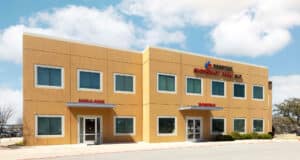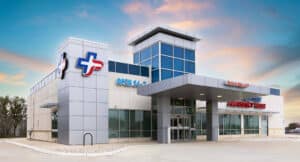Overdose Treatment Services
Every second counts during an overdose—recognizing the signs and knowing where to turn for immediate help can help save lives.
At Prestige ER, our team delivers prompt, expert care when it matters most. Keep reading to learn about common overdose types, lifesaving first-aid steps, and when to call for emergency help.
Types of Overdoses
There are several types of overdose. However, opioids, alcohol, and prescription medications are among the most common.
Opioids
Approximately 125 million opioid prescriptions were dispensed to Americans in 2023. This class of drug is commonly used to help manage moderate to severe chronic pain.
An overdose can happen for several reasons, including if you take the drug to get high, if you take an additional dose of a prescription opioid (or take it too often), or if you mix an opioid with other medicines (e.g., illegal drugs or alcohol). The most common opioids include heroin, fentanyl, oxycodone, and morphine.
Stimulants (Amphetamines)
This class of drug is commonly used to help speed up the body’s system. It is often prescribed and used for attention-deficit hyperactivity disorder (ADHD), performance enhancement, medicinal benefits, and recreational purposes. They are also a popular illegal drug. Common stimulants include crystal meth, cocaine, ecstasy (MDMA), and Ritalin.
Alcohol
Alcohol (e.g., beer, wine, and liquor) is a depressant drug that slows down the central nervous system. It can have short- and long-term effects and may lead to an increased risk of stroke, dementia, and alcohol dependence if overused. Everyone feels the effects of alcohol differently. It’s important to know your limits and what to look for if alcohol poisoning is a concern.
Overdose Symptoms
Physical Signs of Overdose
Physical signs of overdose vary and often depend on the type of overdose. However, potential signs and symptoms may include:
- Very small pupils.
- Choking, gurgling, or vomiting.
- Slowed or irregular breathing.
- Chest pain.
- Difficulty or inability to remain conscious.
- Very low body temperature.
- Seizures.
Behavioral and Cognitive Symptoms
Behavioral and cognitive signs of overdose may include:
- Dizziness or disorientation.
- Headaches.
- Balance issues.
- Judgment issues.
- Confusion or stupor.
- Slurred speech.
- Unresponsive or inability to communicate effectively.
When to Call for Emergency Help
A drug overdose is a medical emergency. Early warning signs of overdose include slowed or irregular breathing, slow heart rate, very low body temperature, and pale or blue-tinged or clammy skin. If you notice someone experiencing any of these signs or symptoms, call 9-1-1 or take them to your nearest emergency room for immediate, life-saving care.
If someone is unresponsive and you suspect they have overdosed, call 9-1-1 immediately.
First Aid Response for Overdose
Initial Steps to Take
Follow these SAVE ME steps below for drug overdose treatment:
- Stimulate.
Start by calling their name, if known. Next, try squeezing the nailbed of their finger or pinching the webbing between their fingers to see if they respond to pain. Always tell someone what you are going to do before doing it. If the person does not respond to sound or pain, call 9-1-1 immediately. - Airway
Check their airway and remove any obstructions (e.g., food, gum, dentures, retainers, or a syringe cap). Once their airway is clear, tilt their head back to open it and confirm whether they are breathing. - Ventilate
If they are not breathing, begin mouth-to-mouth resuscitation to help them avoid an irreversible brain injury. Pinch the nose and create a seal around their mouth with yours. Give one breath every five seconds. - Evaluate
Determine whether the person is responding to your breaths. - Medication
If the person is not responding, continue rescue breathing and administer naloxone (Narcan) if you have it. If you do not have Narcan, continue rescue breaths until first responders arrive. - Evaluate
If you have administered Narcan, monitor the person to see if they respond by breathing on their own or regaining consciousness. If not, continue rescue breathing. If they remain unresponsive for three to five minutes (approximately 40 breaths), you can give a second dose of Narcan. Continue rescue breathing until first responders arrive.
Narcan is an FDA-approved life-saving medication that can temporarily stop or reverse the effects of an opioid or heroin overdose. It can be found behind the front register or at the pharmacy counter at your local drugstore, with no prescription required.
Do’s and Don’ts of Overdose First Aid
DO
- DO support a person’s breathing.
- DO administer Narcan, if available.
- DO put the person in a “recovery position” on their side if they are breathing independently.
- DO stay with the person and keep them warm.
DO NOT
- DO NOT forcibly stimulate the person, as this could cause further injury.
- DO NOT put the person in a cold bath or shower, as this could cause drowning, injury, or shock.
- DO NOT inject the person with any substance other than Narcan.
- DO NOT try to induce vomiting, as this could cause choking or inhaling vomit into the lungs, which can be fatal.
How to Treat Drug Overdose at Prestige ER
Immediate Medical Interventions
If you were unable to administer or did not have access to Narcan, Prestige ER will administer this life-saving medication as a first line of treatment. Additional drug overdose treatments and interventions may include pumping the stomach or administering activated charcoal to help prevent the drug from being further absorbed from the stomach into the body.
Diagnostic and Monitoring Tools
At Prestige ER, our physicians will order and administer the following diagnostic tests:
- Therapeutic trial of Narcan.
- Electrocardiogram (EKG).
- Chest X-ray.
- Abdominal X-ray.
- Abdominal CT scan.
- Opioid urine screen.
All patients are then monitored for recurrence of signs and symptoms of opioid toxicity for at least four hours from the last dose of Narcan. Those who have overdosed on long-acting opioids will have a longer monitoring period.
Medications and Reversal Agents
Nalmefene is another FDA-approved opioid overdose reversal medication (OORM) used to treat acute opioid overdose. This medication remains active in the body longer, potentially making withdrawal symptoms more severe and last longer. Additional OORMs include:
- Kloxxado®
- Zimhi®
- ReVive®
- Opvee®
Frequently Asked Questions
Is an overdose a medical emergency?
Yes. Any overdose that leads to confusion, loss of consciousness, or respiratory issues is a medical emergency. Seek immediate medical care at your nearest Prestige ER location for medicine overdose treatment.
What support is available after an overdose emergency?
The first line of treatment for drug overdose is the SAVE ME protocol from above and a dose of Narcan (or something similar). If you suspect someone has overdosed, follow these steps and call 9-1-1 for immediate medical assistance.
After recovering from an overdose, your emergency room physician will refer you to an addiction rehabilitation facility and recommend a behavioral health specialist. Depending on your unique needs and situation, they may recommend additional follow-up appointments with your primary care provider or specialist.
How can I prevent future overdoses?
Here are tips for preventing future overdoses:
- Avoid using illegal drugs.
- Never use drugs or drink alone.
- Use prescription medications exactly as prescribed.
- Do not use someone else’s prescription medications.
- Do not mix drugs, and do not mix drugs and alcohol.
- Know your alcohol limits and stay hydrated and satiated.
Choose Prestige ER for Emergency Medical Care
Don’t wait to seek care if you suspect an overdose—visit Prestige Emergency Room at the first sign of trouble. Our expert team is ready to provide rapid, reliable drug and medicine overdose treatment in the ER as well as several other medical emergencies.
We are a veteran-owned facility that provides personalized, expert care to you and your family 365 days a year, 24 hours a day. Find a location near you and visit us today.












